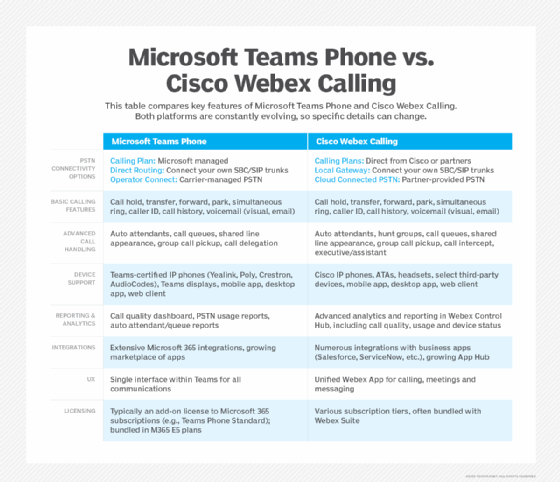
Rawpixel - Fotolia
Webex calling vs. Teams calling: Compare the telephony tools
Although both products have several similarities, Cisco Webex Calling and Microsoft Teams Phone have key differences around integrated services and management.
Cisco's Webex Calling and Microsoft Teams are two of the biggest players in the enterprise cloud calling market, especially among large enterprises. Within the $20 billion global market for unified communications as a service (UCaaS), Microsoft owns about 20% of the market compared to Webex's 17.9%, according to Metrigy's data.
Both platforms have similarities and key differences, requiring IT and business leaders to evaluate each product carefully to determine which is best for their environments.
Webex Calling and Microsoft Teams similarities
Both Webex Calling and Microsoft Teams are cloud-based services that provide PSTN calling capabilities. Both are integrated with their respective vendors' meeting and chat services. Both offer AI virtual assistant capabilities to capture call transcripts and summaries. Both offer options to ensure localized call handling for remote site survivability, as well as mobile integrations. Both platforms also rely on an extensive set of communications service provider partners to provide PSTN connectivity.
Despite all their similarities, both platforms also have key differences that might drive enterprise decision-making.
Cisco Webex Calling
Cisco Webex Calling is often positioned as an upgrade for companies using Cisco's on-premises calling platforms. The migration to the cloud-based product is pretty seamless, enabling customers to preserve their existing investments in Cisco telephones and session border controllers for PSTN access.
Cisco's primary advantage is its integrated management capabilities in Webex Control Hub, which has a single pane of glass that administrators can use to configure and manage their Webex environments, including Webex Calling, Cisco phones, Webex Meetings and Cisco video conferencing equipment.
Cisco also offers an integrated enterprise-grade cloud contact center platform, enabling customers to rely on a single provider for calling, chat, meetings and contact center. Cisco offers hardware and software, all managed via Control Hub.
AI capabilities, including call transcription and summarization, are provided at no additional cost via the Webex Assistant. Cisco also relies on its AI codec to provide high-quality voice conversations, even over lossy networks.
Beyond calling capabilities, Cisco offers an extensive set of security and compliance features, integrated into Control Hub.
Microsoft Teams Phone
Microsoft Teams Phone is delivered as a set of features that extend Teams meetings and chat. For enterprise customers, Teams Phone requires an add-on license for those who have E1 or E3 licenses. Teams Phone features are included with E5 licenses.
Microsoft's key advantage is its integration with Microsoft 365. Customers use the same management interface to configure and manage Teams Phone, while end users have calling features accessible via the Teams app they use for meetings and chat.
Microsoft offers additional add-on licenses to provide additional functionality for Teams Phone. These include Teams Premium, which brings AI capabilities such as language translation into the Teams Phone and meetings experience, and the Microsoft Queues app, which provides additional features for IVR and call queue management. Microsoft also offers a dedicated mobile integration -- delivered through carrier partners including AT&T and Verizon -- which turns a company-provisioned phone into a fully featured Teams Phone, using the mobile device's native dialer.
Microsoft does offer a fully featured contact center service that's part of its Dynamics set of customer engagement offerings. It provides a certification program for third-party contact center vendors, offering a range of integration options. Microsoft does not sell phones of its own, but has an extensive set of partners that offer certified devices.
Microsoft also offers a broader set of PSTN connectivity options, including Microsoft Calling Plan, which provides a set of monthly minutes at a fixed price with different plans for U.S. domestic and long-distance calling. Beyond Calling Plan, Microsoft offers Operator Connect, which enables customers to pick PSTN calling services from among dozens of certified partners, with configuration integrated into the Microsoft Teams management console. Microsoft also offers Direct Routing for larger enterprises that want to maintain control over calling plans and SIP trunking services.

Webex Calling vs. Microsoft Teams Phone: Which is right for you?
Ultimately, the choice between Webex and Microsoft depends on where you are today, where you are going and what features you require. Existing Cisco on-premises customers are going to find an easier transition to Webex Calling. However, those fully immersed in the Microsoft ecosystem for their other collaboration needs might find that Teams Phone better meets their needs.
Larger Cisco customers might decide to adopt a blended approach by continuing to support on-premises calling, while integrating Webex features for group messaging and collaboration.
For those who are not current Cisco and Microsoft customers, evaluate Webex vs. Microsoft Teams offerings based on cost, features and delivery model. By taking this approach, enterprises can ensure that whatever platform they choose should align with present and future needs.
Both Cisco Webex and Microsoft Teams are powerful and capable cloud phone systems. The best choice depends heavily on your organization's specific requirements, existing infrastructure and strategic direction for collaboration. It's highly recommended to conduct pilot programs or demos of both platforms before making a final decision.
Editor's note:This article was updated to reflect changes in Cisco and Microsoft products and services.
Irwin Lazar is president and principal analyst at Metrigy, where he leads coverage on the digital workplace. His research focus includes unified communications, VoIP, video conferencing and team collaboration.








